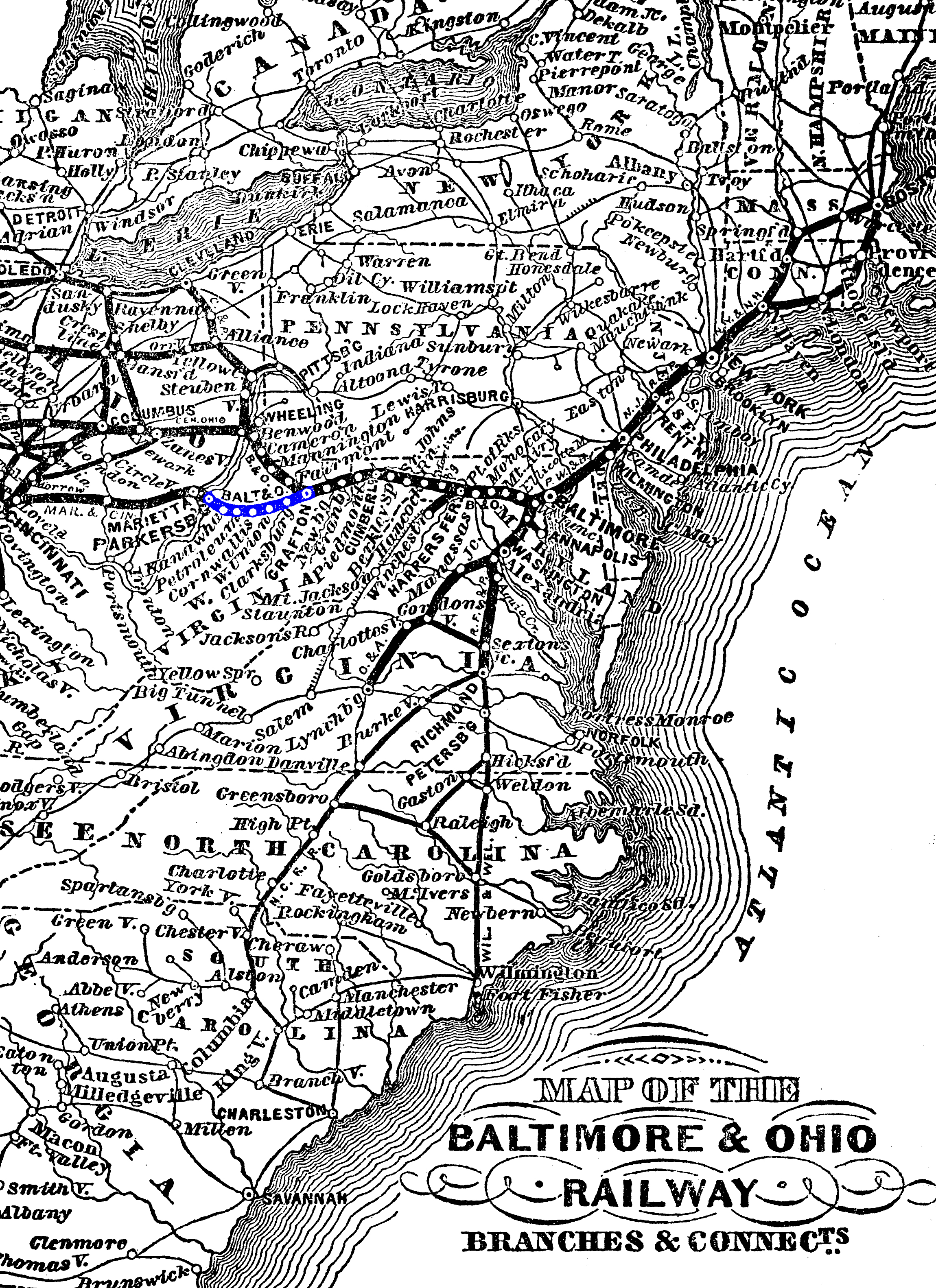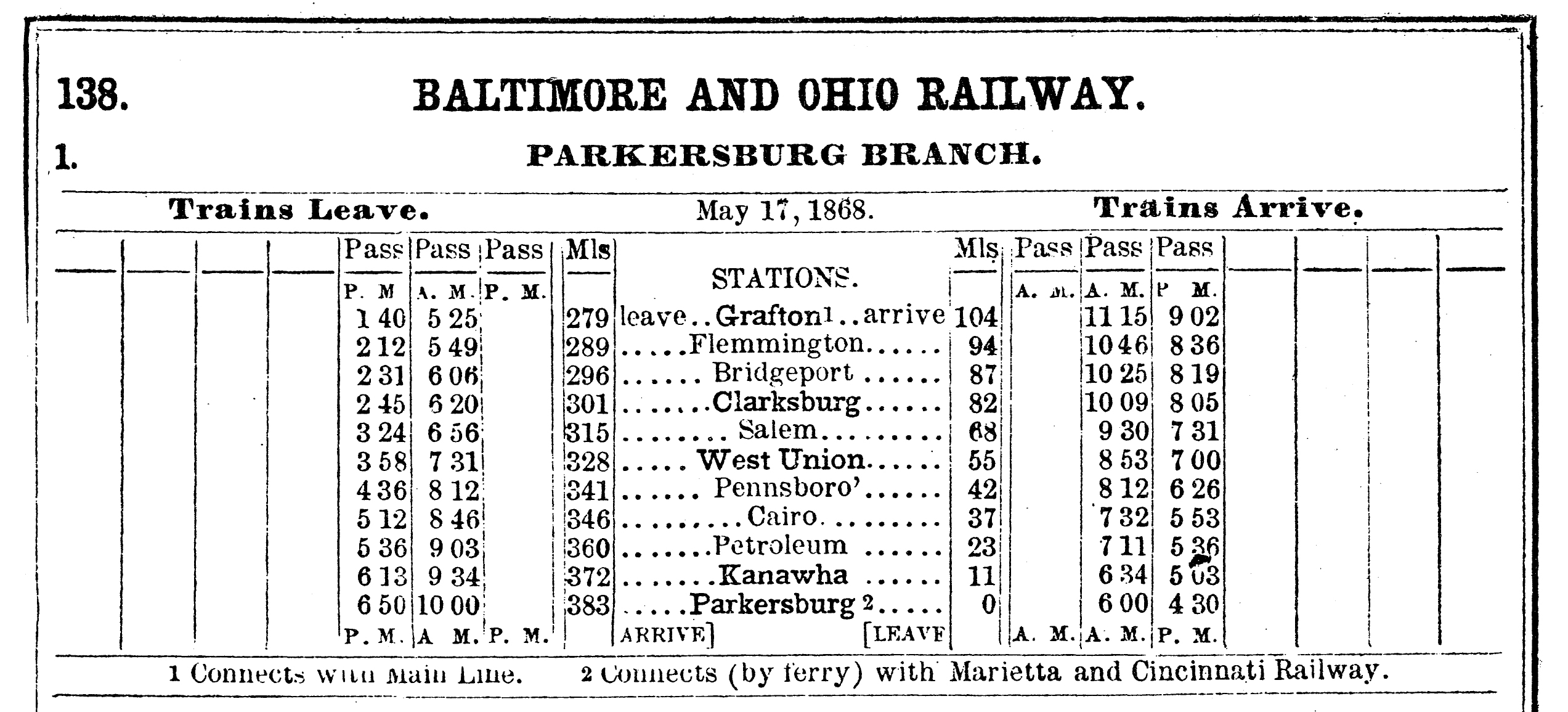Northwestern Virginia Railroad: Map, History, Timetable
Published: January 29, 2025
By: Adam Burns
On February 14, 1851, the Virginia General Assembly granted a charter for the Northwestern Virginia Railroad. This endeavor aimed to construct a line connecting Grafton to Parkersburg (104 miles), both situated in today's West Virginia.
In 1852, Peter G. Van Winkle, who would later champion statehood and serve as a U.S. Senator, began his involvement with the railroad as its secretary. He eventually rose to the position of president, a role he held throughout the tumultuous years of the American Civil War.
The NV, although not as widely recognized today, played an instrumental role in connecting important economic regions and fostering regional development in its heyday.
The system was acquired by the B&O in 1856 before its completion the following year. Known as the "Parkersburg Branch," it became an important component of the Baltimore road, acting as part of its main line to St. Louis.
Despite spending millions in upgrades during the early 1960s to improve tunnel clearances for trailer-on-flatcar (TOFC) service, then-CSX elected to downgrade the route in 1985 and rails over the line were removed in 1988.
System Map (1868)
Origins and Conception
The inception of the Northwestern Virginia Railroad dates back to the mid-1800s, a pivotal era in U.S. history characterized by rapid industrialization and expansion westward.
The idea for the railroad was born out of a need to connect the resources of the western counties of Virginia, which is present-day West Virginia, to the bustling markets and ports in the east. The rugged terrain and expansive forests rich with timber, coal, and other resources provided a lucrative motive for improving transportation infrastructure.
In the early 1850s, local businessmen and politicians began to seriously consider the construction of a railroad to better connect this region of Virginia.
Their vision was to have a line branch from the B&O at Grafton and reach the Ohio River port of Parkersburg. The B&O saw the NV as another means of continuing its march westward while providing a more direct link to the river.
Timetable (1868)
Construction and Development
Construction of the NV began at Grafton in late 1852. While it was meant to operate independently, the project obtained substantial financial backing from Baltimore.
By December 1856, the B&O had leased the property and the route was finished and opened to Parkersburg on May 1, 1857. Essentially, this turned the NV into B&O’s third branch, establishing Parkersburg as its second port on the river.
It was a very difficult construction through the Appalachian foothills, requiring a total of 22 tunnels, numerous bridges, and sharp curves between Clarksburg and Parkersburg. Interestingly, it remained a difficult line to operate until its 1985 abandonment.
B&O's Continued Expansion
When the B&O initially reached the Ohio River in 1852, plans for other railroads in Ohio, Indiana, and Illinois were already underway or in development. Key to B&O’s growth was the Central Ohio Railroad, established in February 1847 to construct a line from Columbus to Bellaire, just across the Ohio River from Wheeling.
Work began in 1852, wrapping up two years later. The Buckeye State saw several railroads constructed throughout the 1830s and 1840s, built to the so-called "Ohio gauge" of 4 feet, 10 inches, which was adopted by the Central Ohio.
Another important component was the Marietta & Cincinnati. This line aimed to connect the Ohio River towns of Marietta and Cincinnati, providing a transportation option independent of relying on the river. Built to standard gauge, the M&C line opened in early 1857, coinciding with Northwestern Virginia's expansion to Parkersburg.
With its completion to Loveland, Ohio and interchange at that point with the Little Miami Railroad, the B&O, NV, and M&C provided a direct rail link to Cincinnati, Ohio.
Three decades after B&O’s inception, the company found itself competing with railroads rather than canals. Both the New York Central and the Erie linked the Hudson River with Lake Erie. Meanwhile, the Pennsylvania Railroad bridged Philadelphia to the Ohio River at Pittsburgh.
As the territories transformed into the states of Ohio, Indiana, and Illinois, numerous railroads sprung up, connecting to these key Northeastern trunk lines. These railroads solidified the commercial bonds formed between the burgeoning states north of the Ohio River and the established Northeastern states.
Economic and Social Impact
The economic impact of the NV was profound. By linking to the B&O, it provided access to broader national and international markets. The surging demand for coal and timber from the region fueled both local and national industries.
Towns such as Grafton, Clarksburg, and Parkersburg became important stops along the line, each experiencing economic booms as a result of increased trade and mobility - in particular the oil and gas industry which sprang up during the latter 19th century.
The social ramifications were equally significant. The railroad not only provided jobs during its construction but also ongoing employment for many in the region through its operations.
It broke down the isolation of rural communities, ensuring that goods, news, and culture could flow freely, fostering a greater sense of unity and identity. With improved access to urban centers, educational opportunities expanded, influencing social structures and contributing to a gradual shift from agrarian lifestyles to more urban-centric living.
Modern Operation
Following the B&O's 1856 acquisition, the NV would eventually become the central spine - the "Parkersburg Branch" - of its main line to St. Louis main line, a key Midwestern market only three eastern trunk lines would reach (B&O, NYC, and PRR).
In 1963 the B&O, then a subsidiary of the Cheapeake & Ohio Railway, embarked upon a major improvement project of the Parkersburg Branch; several tunnels were either daylighted, bypassed, or had their floors lowered to handled trailer-on-flatcar business - essentially, truck trailers moved by rail.
Unfortunately, for reasons still unclear to this day, early CSX management during the 1980s elected to downgrade the route. Traffic was largely moved off the line in 1985 and rails were pulled from Clarksburg to Parkersburg in 1988. In addition, much of the former Marietta & Cincinnati - B&O's Ohio Division - was also abandoned.
Legacy and the Modern Era
Today, the legacy of the Northwestern Virginia Railroad persists. Most of the right-of-way can now be biked or hiked as part of the North Bend Rail Trail which is part of the North Bend State Park.
For the areas once served by the railroad, it remains a symbol of industrial development and the transformative power of innovation.
Historically preserved sites and museums in former railroad towns celebrate this heritage; be sure to check out preserved depots at Salem, Smithburg, and Pennsboro. You can also still find some of the bypassed tunnels along the trail.
Conclusion
The Northwestern Virginia Railroad was more than just a means of transportation. It was a catalyst for economic growth and social transformation in the mid- to late-1800s, reflecting the broader story of American expansion and industrial progress. While it may no longer operate in its original form, the railroad's historical contributions to regional development are undeniable and continue to be recognized today.
Despite being no more, the Northwestern Virginia exemplifies the essential role of railroads in the United States' growth and prosperity, marking an era where iron rails bridged the distances between isolated communities and vibrant economic hubs. Its history is not only a testament to human ingenuity and perseverance but also a reminder of how the past continues to shape the present.
Recent Articles
-
Colorado - Wine Tasting - Train Rides
Dec 25, 25 08:04 PM
To truly savor these local flavors while soaking in the scenic beauty of Colorado, the concept of wine tasting trains has emerged, offering both locals and tourists a luxurious and immersive indulgenc… -
Kentucky -Wine Tasting- Train Rides
Dec 25, 25 12:15 PM
Kentucky, often celebrated for its rolling pastures, thoroughbred horses, and bourbon legacy, has been cultivating another gem in its storied landscapes; enjoying wine by rail. -
Iowa -Wine Tasting- Train Rides
Dec 25, 25 12:12 PM
In this immersive article, passengers embark on a journey that combines the delights of wine tasting with the nostalgia of a leisurely train ride.





